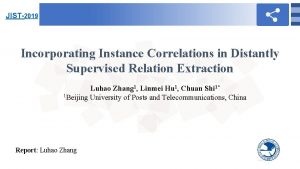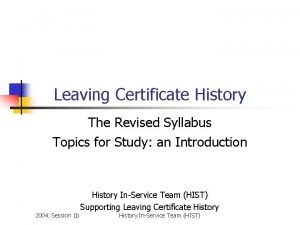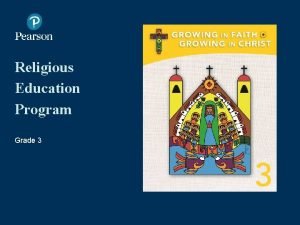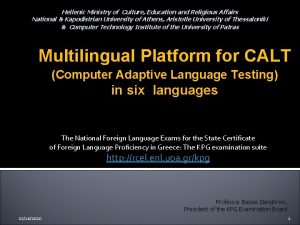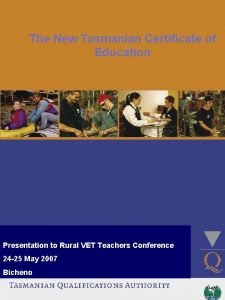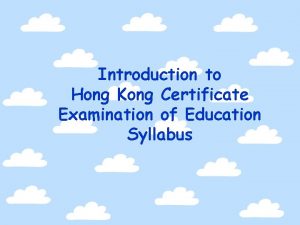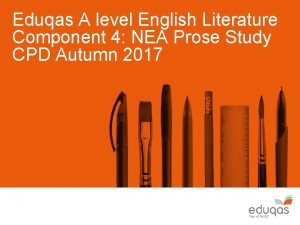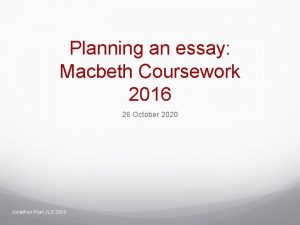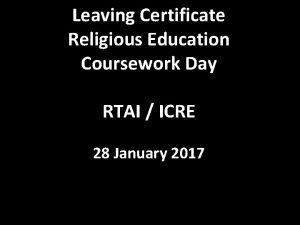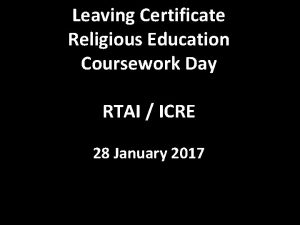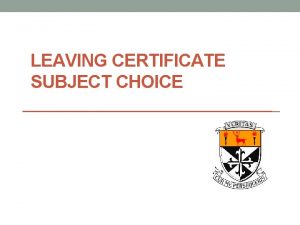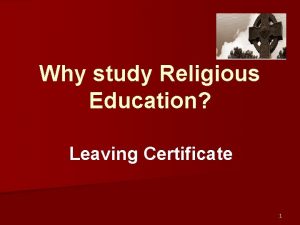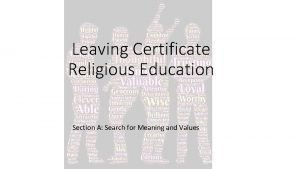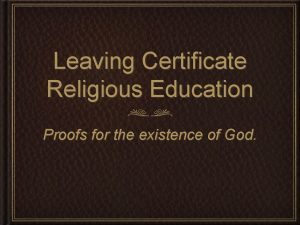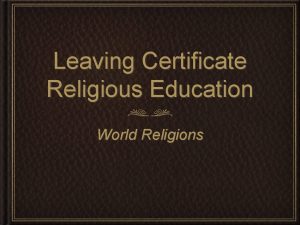Leaving Certificate Religious Education Coursework Day RTAI ICRE

































- Slides: 33

Leaving Certificate Religious Education Coursework Day RTAI / ICRE 28 January 2017

G. 1 Worship Prayer and Ritual

A profile of the origins of using mantra and sacred text in meditation techniques and the significance of these forms of prayer for members of one major world religion today.

• Two of the key words in this topic (mantra, and meditation) alert us to the fact that we are in the presence of religions of South Asian origin. • It would be inaccurate to refer to them as Indian Religions, as they are all found outside of India as well as the fact that their origins lie in the period before the modern state of India became independent (1947). • The area where these religions had their origins and to which they spread is far wider than the contemporary Republic of India.


INDIC CULTURAL ZONES INDIAN SUBCONTINENT: India, Pakistan, Sri Lanka, Nepal, Bhutan, Bangladesh CULTURALLY LINKED: Burma, Thailand, Cambodia, Laos, Vietnam, Malaysia, Indonesia NOT IN INDIC CULTURAL ZONE (but historically linked): Afghanistan, Tibet, Yunnan (China) and Philippines

• As well as the designation Religions of South Asian Origin (which is geographical), we also see these religions referred to as Dharmic Religions. • The word Dharmic is an adjective formed from the Sanskrit noun Dharma which can be translated in a wide range of ways, depending on the context (to say nothing of the particular religion). • Sanskrit – an ancient Indo-European language plays a key role, as we shall see, in the Dharmic Religions – especially in terms of our topics today.

धरम DHARMA The word Dharma comes from the Sanskrit root dhṛ which means hold, support, keep or maintain.

• So what are these Dharmic Religions or Religions of South Asian Origin? • • • HINDUISM BUDDHISM JAINISM SIKHISM Our focus today will be on Hinduism sometimes seen as the oldest of these religions, but much of what we say today can be adapted to one of the others.

• A note of caution: The Guidelines speak of major world religion – and we basically know what this means, however, we should be aware that there is no agreement among scholars and adherents of these phenomena as to what a religion actually is, to say nothing of the concept of world religion. • Part of the problem and source of the lack of agreement is the use of what are essentially western Christian-derived terms that may not make sense to adherents of other religions, such as Hinduism. • For example the Prescribed Titles document speaks of mantra and meditation techniques as ‘forms of prayer’. Many Hindus, Buddhists, Jains or Sikhs may not find these terms adequate or suitable.

• However, we have to work with what we are given, so even though these concepts are somewhat contested, we need to make a treaty with reality. • Any kind of education or explanation involves making something complex easier to understand. To do this we use maps and models. But it is vital to remember that these maps and models are not the things themselves. • This may seem like a very obvious point – and in some ways it is BUT it is a point that teachers like me need to remind themselves of frequently. • The map is not the territory (Korzybski); The menu is not the meal (Watts).


THE KEY TERMS

MANTRA • A MANTRA is a sacred sound, word, or verse from scripture. • Mantra is Sanskrit for ‘instrument of thought. ’ • Mantras in Hinduism are always in Sanskrit, the language of the most important sacred texts of Hinduism – the VEDAS. • Reciting a MANTRA silently or aloud is not only an aid to MEDITATION, it is a FORM of meditation. • The origins of MANTRAS – like the origins of Hinduism itself – are very mysterious and probably lie in prehistory (the time before writing). • Most Hindus believe that the ultimate source of MANTRAS is BRAHMAN – the ABSOLUTE – ULTIMATE REALITY.

MANTRA • MANTRAS are very closely linked with the most important Hindu SACRED TEXTS – the VEDAS – and the language of their composition: SANSKRIT. • VEDA means KNOWLEDGE. • Acceptance of the authority of the VEDAS is probably one of the only widely agreed criteria for being Hindu. • The Vedas were transmitted orally for many centuries (or millennia) until they were finally committed to writing in the 2 nd century BCE. • Most Hindus believe that these texts were ‘heard’ (SHRUTI) BY SAGES (RISHIS) – not actually composed them (a type of revelation)

The Sanskrit Writing System


AUM

MANTRA • AUM is probably the most famous and simplest of all Hindu mantras. • AUM or OM (as it is sometimes written) ॐ – does not have a simple meaning as such. In that regard it is an excellent example of a mantra as an ‘instrument of thought’. • The single syllable AUM is said to represent all of the VEDAS. • The process of saying AUM aloud is seen as a representation of the three cycles of cosmic creation: CREATION, MAINTENANCE and DESTRUCTION. • Recitation of a mantra is also seen as having direct physical effects upon the user.

GAYATRI MANTRA The GAYATRI MANTRA is an invocation of the sun and is transmitted during the sacred thread initiation ceremony (upanayanam). It is taken from the VEDAS – close link between MANTRA and SCRIPTURE.

VEDAS • As previously noted, the VEDAS are the most important sacred texts of Hinduism. • Many Hindus believe that the VEDAS contain ALL KNOWLEDGE – not just things related to Hinduism. • As noted, their origins are contested, with most traditional Hindus believing them to be eternal – like the universe itself. • The VEDAS are the source of many MANTRAS, such as the GAYATRI mantra seen above.

Printed Text of the Vedas

MEDITAION • We are all familiar with mediation or some form of it. For example the mindfulness that we hear so much of these days is actually based on a form of Buddhist meditation. • Meditation differs from one Dharmic religion to another in terms of how it is done and what it aims to achieve. • In Hinduism, meditation is known by the Sanskrit term DHYANA – contemplation, reflection, sustained attention. • Meditation in Hinduism is seen as having many benefits for the meditator in the here-and-now. • However, the ultimate aim of meditation for a Hindu is to achieve MOKSHA – liberation from the cycle of SAMSARA

(RE)BIRTH DEATH SAMSARA LIFE

• SAMSARA is the eternal cycle of birth, death, rebirth and so on. • One’s present life is just one in a countless series of existences that extends far into the past, if not eternity. • These previous existences may not all have been human, and each of them has a bearing on the next.


MOKSHA

MOKSHA (RE)BIRTH DEATH SAMSARA LIFE

• The word moksha literally means liberation or release and refers to liberation or release from the cycle of birth, life, death and rebirth (samsara). • Achieving moksha is the ultimate goal of Hinduism. • Other ways of working towards moksha evolved over time: these are known as yogas. • The word yoga literally means yoking or joining (indeed it is related to the English word yoke). • A yoga is a practice (physical or psychological) whose aim is moksha from the cycle of birth, death, rebirth (samsara): meditation is a yoga.

RESOURCES


Routledge, 2006

Dunedin, 2010
 Day 1 day 2 day 3 day 4
Day 1 day 2 day 3 day 4 Icre plot
Icre plot Leaving certificate history syllabus
Leaving certificate history syllabus Primary school leaving examination in chinese
Primary school leaving examination in chinese Leaving certificate
Leaving certificate Day 1 day 2 day 817
Day 1 day 2 day 817 Opening prayer for grade 3
Opening prayer for grade 3 Hellenic ministry of education and religious affairs
Hellenic ministry of education and religious affairs Lcpe
Lcpe College signing day certificate template
College signing day certificate template Coc certificate of completion
Coc certificate of completion Tasmanian certificate of education
Tasmanian certificate of education Hong kong certificate of education examination
Hong kong certificate of education examination Unit 14 physiological disorders examples
Unit 14 physiological disorders examples Ocr imedia
Ocr imedia Gcse graphics coursework
Gcse graphics coursework Verna williams and sam williams
Verna williams and sam williams P3 unit 5 health and social care
P3 unit 5 health and social care Horizontal anatomical plane
Horizontal anatomical plane Ocr product design gcse
Ocr product design gcse Health and social care component 1 coursework example
Health and social care component 1 coursework example A level english literature nea example
A level english literature nea example Macbeth peel paragraph
Macbeth peel paragraph Supplemental online coursework
Supplemental online coursework Media studies gcse past papers
Media studies gcse past papers Gcse art coursework checklist
Gcse art coursework checklist A level history coursework bibliography
A level history coursework bibliography History gcse coursework
History gcse coursework Religion coursework
Religion coursework Media magazine coursework
Media magazine coursework Design technology gcse coursework
Design technology gcse coursework Gcse pe coursework action plan
Gcse pe coursework action plan Family portal schoolmax
Family portal schoolmax Oceans apart day after day meaning
Oceans apart day after day meaning

